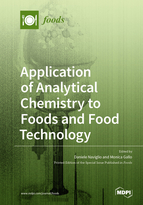Application of Analytical Chemistry to Foods and Food Technology
A special issue of Foods (ISSN 2304-8158). This special issue belongs to the section "Food Analytical Methods".
Deadline for manuscript submissions: closed (31 March 2020) | Viewed by 83780
Special Issue Editors
Interests: gas chromatography; HPLC; lipids; butter; oils; solid-liquid extraction; food and beverages; saffron; food; supplements
Special Issues, Collections and Topics in MDPI journals
Interests: antioxidants; bioactive compounds; biological fluids; diet; disease prevention; extraction techniques; food; functional foods; health; macro- and micronutrients; nutraceuticals; phytochemicals
Special Issues, Collections and Topics in MDPI journals
Special Issue Information
Dear Colleagues,
Two centuries ago, the application of Analytical Chemistry to the study of food composition gave life to a new science named “Bromatology” (from the Greek βρῶμα, brṑma, "food"). This science can be considered as a branch of chemistry that deals with the study of foods, emphasizing the aspects related to the qualitative and quantitative characterization of its components (lipids, proteins, carbohydrates, etc.) and nowadays is referred to as Food Chemistry. This new science studies the chemical composition of foods and the properties of their constituents, which contribute to defining their nutritional and product value. Furthermore, it studies the chemical modifications that food constituents undergo as a result of treatments to which they are subjected (Food Technology). Therefore, food analysis makes it possible to determine the quality of a product or its nutritional value; moreover it makes it possible to reveal adulterations and identify the presence of xenobiotic substances potentially harmful to human health. Furthermore, some foods, particularly those of plant origin, contain numerous substances with beneficial health effects. These functional compounds can be ingested not only through proper nutrition but also as extracts from vegetable matrices used in the formulation of nutraceutical products or added to foods by technological or biotechnological means for the realization of functional foods. The huge growth of the industry of food in the last fifty years has enlarged the field of application of analytical chemistry to not only foods but also food technology that is fundamental to increase the production of all types of food. In this Special Issue, “Application of Analytical Chemistry to Foods and Food Technology”, we invite all specialists and researchers working in this field to submit scientific articles in which analytical chemistry is applied to the analysis of foods and/or to the study or evaluation of food technologies and that could be of reference for future applications.
Prof. Daniele Naviglio
Prof. Monica Gallo
Guest Editors
Manuscript Submission Information
Manuscripts should be submitted online at www.mdpi.com by registering and logging in to this website. Once you are registered, click here to go to the submission form. Manuscripts can be submitted until the deadline. All submissions that pass pre-check are peer-reviewed. Accepted papers will be published continuously in the journal (as soon as accepted) and will be listed together on the special issue website. Research articles, review articles as well as short communications are invited. For planned papers, a title and short abstract (about 100 words) can be sent to the Editorial Office for announcement on this website.
Submitted manuscripts should not have been published previously, nor be under consideration for publication elsewhere (except conference proceedings papers). All manuscripts are thoroughly refereed through a single-blind peer-review process. A guide for authors and other relevant information for submission of manuscripts is available on the Instructions for Authors page. Foods is an international peer-reviewed open access semimonthly journal published by MDPI.
Please visit the Instructions for Authors page before submitting a manuscript. The Article Processing Charge (APC) for publication in this open access journal is 2900 CHF (Swiss Francs). Submitted papers should be well formatted and use good English. Authors may use MDPI's English editing service prior to publication or during author revisions.
Keywords
- Lipids
- Gaschromatography
- Saffron
- Eggs
- Butter
- Olive oil
- Antioxidants
- Phytochemicals
- Bioactive compounds
- Nutraceuticals
- Functional foods
- Solid-liquid extraction techniques
- Liquid chromatography (HPLC)
- Mass spectrometry








